The octagonal trigram template is a common symbol for the term Bagua.
The template has eight (ba) areas (guas), connecting two neighbouring corners of the octagonal trigram towards the centre to form one gua. The centre contains the yin and yang symbol, or taijitu as per taoist philosophy.
Each of the ‘guas’ shows three yao symbols, stretching in three rows from the centre to the outer side.
Each single yao symbol (line symbol) is either yin (陰 (阴); representing the receptive (female) force of nature, or yang (陽 (阳); representing the creative (male) force of nature.

Yao Symbols
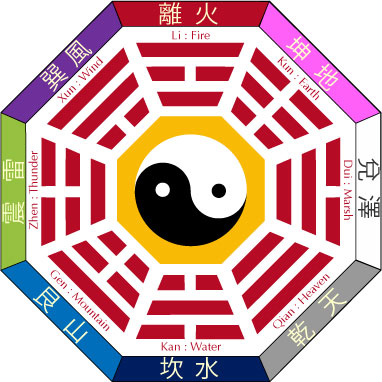
Bagua Octagon with Later Heaven Order
Note: The direction 'South' is always found at the top of the Bagua.
| The names of the gua and the yao symbols are as follows (note: incorrect order of guas, Later Heaven Sequence) |
| Yao name |
Yao symbol |
|
|
|
Element |
| K’un yao |
☷ |
yin |
yin |
yin |
Earth |
| Zhèn (also Chen) yao |
☶ |
yang |
yin |
yin |
Thunder |
| Li yao |
☲ |
yang |
yin |
yang |
Fire |
| Dui (also Tui) yao |
☴ |
yang |
yang |
yin |
Marsh/Lake |
| Gen (also K’en) yao |
☳ |
yin |
yin |
yang |
Mountain |
| K’an yao |
☵ |
yin |
yang |
yin |
Water |
| Xùn (also Sun) yao |
☱ |
yin |
yang |
yang |
Wind |
| Qian (also Quian) yao |
☰ |
yang |
yang |
yang |
Heaven |
| |
|
|
|
|
|
According to Feng Shui belief, the positive chi energy in ones life, environment and living area should be balanced. Off-balanced areas or aspects of life can be readjusted with corresponding items and symbols in corresponding colours, leading to a harmonious and balanced chi energy flow. The chi energy is supposed to improve life, while one is living in harmony with nature.
In Feng Shui, the Bagua template or map is used to stabilize, protect, adjust or restore balance in ones life by analysing or structuring any given space.
Each section of the structured space is believed to relate to various aspects of life and is divided into categories concerning i.e. physical and emotional aspects of life like family, career etc.
There are two types of bagua: the Early Heaven Sequence and the Later Heaven Sequence (see below).
Both types have been developed before the ‘Book of Changes’, the I Ching, which describes the cosmology and philosophy of ancient China. The basic ideas are: balance through opposites and acceptance of change.
Both baguas are associated with the eight compass directions, both baguas use cardinal directions. The cardinal directions are determined by the marker-stars of the mega-constellations known as the Four Celestial Animals.
| Direction |
Celestial Animal |
|
| East |
the Bluegreen Dragon |
Spring equinox |
| South |
the Red Bird |
Summer solstice |
| West |
the White Tiger |
Autumn equinox |
| North |
the Dark (Mysterious) Turtle |
Winter solstice |
EARLY HEAVEN SEQUENCE
The Early Heaven Sequence is also called the Primordial Bagua, The River Chart (Hetu) and is an arrangement of opposites. Earlier Heaven arrangement refers to the archetypal order of things before creation, before changes.
In yin-yang cosmology, the taiji is preceded by wuji. Wuji separates into taiji or yin and yang. Two symbols became four symbols. The four symbols became bagua (ba- eight, gua- area). Bagua describes all things of creation.
Fuxi (伏羲, Fu Xi or Fu Hsi, culture hero and sage) is considered to be one of the 3 Sovereigns of the ancient period of the "3 Sovereigns and 5 Emperors" of China (2850 - 2200 BC) and was said to have revealed the 8 trigrams.
Fuxi ‘s definition:
“The Limitless (Wuji) produces the delimited, and this is the Absolute (Taiji).
The Taiji produces two forms, named Yin and Yang.
The two forms produce four phenomena, named lesser yang, great yang (tai yang also means the Sun), lesser yin, great yin (tai yin also means the Moon).
The four phenomena act on the eight trigrams (ba gua), eight eights are sixty-four hexagrams.”
Or, in other words:
'Changes originate in the Ultimate; from the Ultimate issue the two spheres. From the two spheres issue the four elements, and from the four elements the eight diagrams' (from the book Zhou Yi, 周易 (I Ching, 易經, The Book of Changes). That was the basic theory of the Ultimate, giving rise to the eight diagrams. By the Ultimate, the ancient meant the origin of all things and creatures. The two spheres refer to heaven and earth, or yin (feminine, negative) and yang (masculine, positive). The four elements are metal, wood, water and fire, which are omnipresent. The eight diagrams symbolize the eight natural phenomena: sky, earth, thunder, wind, water, fire, mountain and lake. So, the picture represented the ancient Chinese early knowledge of the universe.
To clarify the above:
The basic idea of the ‘Yin- Yang Theory’ consists of two natural, complementary and contradictory forces of any phenomena in our universe, the principle of opposite polarity and duality. All forces in the universe can be classified as yin or yang energy.
As already described, in the bagua, yin is described with two short lines, yang is described as one continuous line.

Yin - Yang
From yin and yang, the four images are formed by placing the addition of a second line (applying 2 squared) yin and yang, the determination of influence is the bottom line. The yin-yang elements or ‘energies’ are constantly moving and influencing each other, creating old/great yang, young/lesser yang, young/lesser yin, old/great yin.
These four ‘pictures’, four ‘directions’ are also called four xiàng or sì xiàng.

Note that above order is for understanding only, since per definition of the yin-yang theory ‘energy wise’ the row should go “old yang, young yang, old yin, younger yin.”
As yin and yang are applicable to all forces of nature, the theory can be applied to the moon and its phases.
Full moon is characterised by old yang. The moon’s decline through the phases to the first quarter is characterised by young-yang. When there is a full moon, it’s characterised by old-yin. The last quarter of the moon is characterised by young-yin.
So it is with the directions: from South (characterised by old-yang), to West (characterised by young-yang), to North (characterised by old-yin), and to East (characterised by young-yin).
So it is with the year’s seasons: from summer (characterised by old-yang), to autumn (characterised by young-yang), to winter (characterised by old-yin), and to spring (characterised by young-yin).
According to legend, after having encountered a mysterious dragon horse on the Yellow River, the Early Heaven Sequence with its trigrams was created by Fuxi, who added a third line to the already existing four images: yin and yang cubed, or 2cubed, hence 8, possible trigrams.
These eight trigrams are Heaven, Earth, Water, Fire, Wind, Thunder, Mountain and Lake.

Eight Trigrams
These Eight Trigrams are arranged into their opposites, forming an octagon called bagua.
The use of an octagon to arrange the trigrams is in itself representative of the tension of change, as the centre is struck between four polar opposite.
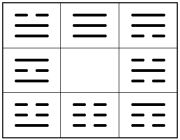
Quadrat Bagua Early Heaven Sequence
Note: 'South' is always found at the top of the Bagua.
| EARLY HEAVEN SEQUENCE |
| GUA |
DIRECTION |
NATURE |
SEASON |
FAMILY |
PERSONALITY |
MEANING |
| Qian/ Quian |
South |
Heaven |
Summer |
Father |
creative |
expansive energy, the sky |
Xun/
Sun |
Southwest |
Wind |
Summer |
Eldest Daughter |
gentle |
gentle penetration, flexibility |
| K'an |
West |
Water |
Autumn |
Middle Son |
abysmal |
danger, rapid rivers, the abyss, the moon |
| Gen |
Northwest |
Mountain |
Autumn |
Youngest Son |
still |
stillness, immovability |
| K'un |
North |
Earth |
Winter |
Mother |
receptive |
receptive energy, that which yields |
| Zhen |
Northeast |
Thunder |
Winter |
Eldest Son |
arousing |
excitation, revolution, division |
| Li |
East |
Fire |
Spring |
Middle Daughter |
clinging |
rapid movement, radiance, the sun |
| Dui |
Southeast |
Lake |
Spring |
Youngest Daughter |
joyous |
joy, satisfaction, stagnation |
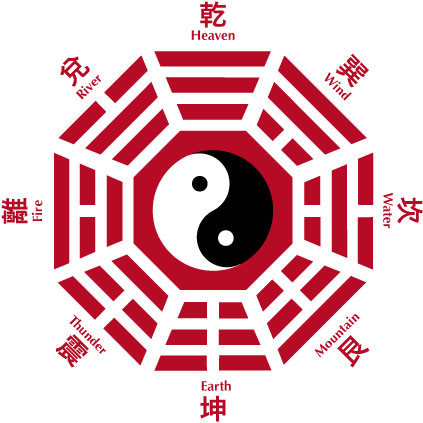
Image of the Ultimate and the Eight Diagrams in Early Heaven Sequence
(Note: In the image above the Chinese characters are the names of the Guas, 'South' is always found at the top of the Bagua.)
According to legend, the concept of the bagua symbolised in the picture above was created by Fuxi (伏羲), the mythical creator of fishing, trapping, and writing.):
"The Ultimate consists of a black and a white fish -- also called the yin and yang fish" (Fuxi must have been an early incarnation of Douglas Adams).
The Guas' names and meanings:
| Qian |
乾 |
qián; other meanings: a surname; male; strong |
| Sun |
巽 |
xùn; other meaning: obey |
| Kan |
坎 |
kǎn; meanings: pit; threshold |
| Gen |
艮 |
gèn; meanings: a surname |
| Kun |
坤 |
kūn; other meanings: the earth; female-principle |
| Zhen |
震 |
zhèn; other meanings: shake; shock |
| Li |
離 |
simplified: 离; pinyin: lí; other meanings: to leave; to depart; to go away; from |
| Dui |
兌 |
simplified: 兑; pinyin: duì; other meaning: to cash |
LATER HEAVEN SEQUENCE
The Later Heaven sequence is also called the Manifested Bagua, The Lo (River) Chart (Luoshu) and refers to the order of change in the manifest world, embodying the cycle of birth and death, the day, and as well as the 24 Jieqi (jieqi: 24 seasonal markers, which follow the solar year, see: Chinese Calendar), time, anatomy, geography, geomancy, astrology, and astronomy.
Another philosophical description of the source of the bagua is the following by King Wen of the Zhou Dynasty (1122-256 BC): 'When the world began, there was heaven and earth. Heaven mated with the earth and gave birth to everything in the world. Heaven is Qian-gua, and the Earth is K'un-gua. The remaining six guas are their sons and daughters'.
| GUA |
|
DIRECTION |
NATURE |
SEASON |
FAMILY |
PERSONALITY |
MEANING |
| Li |
離 |
South |
Fire* |
Summer |
Middle Daughter |
clinging |
rapid movement, radiance, the sun |
| K'un |
坤 |
Southwest |
Earth* |
Summer |
Mother |
receptive |
receptive energy, that which yields |
| Dui |
兌 |
West |
Lake/
Marsh |
Autumn |
Youngest Daughter |
joyous |
joy, satisfaction, stagnation |
| Qian/ Quian |
乾 |
Northwest |
Heaven |
Autumn |
Father |
creative |
expansive energy, the sky |
| K'an |
坎 |
North |
Water* |
Winter |
Middle Son |
abysmal |
danger, rapid rivers, the abyss, the moon |
| Gen |
艮 |
Northeast |
Mountain |
Winter |
Youngest Son |
still |
stillness, immovability |
| Zhen |
震 |
East |
Thunder |
Spring |
Eldest Son |
arousing |
excitation, revolution, division |
| Xun/ Sun |
巽 |
Southeast |
Wind* |
Spring |
Eldest Daughter |
gentle |
gentle penetration, flexibility |
*Note: some trigrams are also among the Five Elements of Wu Xing (Chinese: 五行; pinyin: wǔxíng): Water and Fire. The element of Earth corresponds with both, the trigrams of Earth and Mountain. The element of Wood corresponds with the trigrams of Wind (as a gentle but inexorable force that can erode and penetrate stone) and Thunder. The element of Metal corresponds with the trigrams of Sky (Heaven) and Lake (Marsh).
See also:  Chart of the Five Elements Chart of the Five Elements
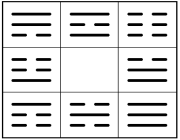
Quadrat Bagua Later Heaven Sequence
Note: 'South' is always found at the top of the Bagua.
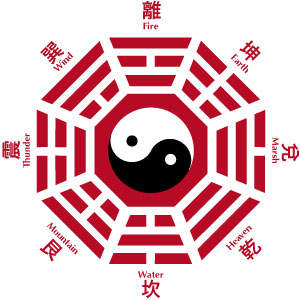
above: I Ching Bagua, Octagon Later Heaven Sequences
Note: 'South' is always found at the top of the Bagua.
The above eight trigrams show a static view. To specify a dynamic change, the process of change, the ba gua was ‘enlarged’ to 64 hexagrams by interaction of each trigram with itself and the remaining seven (8x8).
The first diagram is supposed to show the inner aspects of the current, ongoing change, whereas the second trigram will picture the outer aspect of the current, ongoing change.
Hence, the inner aspect (a person) is combined with the outer aspect (a situation).
Each hexagram represents a process, a change happening at the present moment.
The hexagrams are ‘advices’ with incorporated concepts, mnemonics for philosophic concepts, based on a philosophical idea of balance through opposites and acceptance of change.
In the I Ching, each single of the 64 guas is described. Later in time, interpretations and commentaries were added.
Commonly, Feng Shui believers use the below bagua, interpretations are based on the I Ching. Note that colours are ‘in motion’ as well.
| GUA |
Direction |
Element |
Colour |
Family |
Body Part |
|
Attribute |
| Li |
south |
Fire |
red, orange, purple |
2nd daughter |
eye |
1 |
light giving, dependence |
| K’un |
southwest |
Earth |
pink, white, beige, red |
mother |
belly, organs |
2 |
devoted, yielding |
| Dui |
west |
Metal, Swamp, Marsh, |
white, grey, silver |
3rd daughter |
mouth |
3 |
pleasure |
| Qian/ Quian |
northwest |
Heaven, Aether |
white, grey, silver |
father |
head |
5 |
strong |
| K’an |
north |
Water |
black, blue |
2nd son |
ear |
6 |
dangerous |
| Gen |
northeast |
Mountain |
blue, black, green |
3rd son |
hand |
7 |
resting, stand-/ keeping still |
| Zhen |
east |
Wood |
green |
1st son |
foot |
4 |
initiative |
| Xun/ Sun |
southeast |
Wind, Wood |
purple, purple blue, purple reddish, brown |
1st daughter |
hip |
8 |
penetrating |
| yin- yang |
Centre |
Centre |
yellow, sandy-earthy tones |
|
|
|
|
| GUA |
STAGE |
PLACEMENT |
SHAPE |
ANIMAL |
LIFE AREA |
| Li |
clinging, adaptable, clarity |
rear middle |
triangular |
pheasant |
fame, reputation |
| K'un |
receptive |
rear right |
triangular |
cow |
relationship, love, mother |
| Dui |
tranquil, complete devotion |
middle right |
round, mounded |
sheep |
creativity, future, children |
| Qian/ Quian |
creative |
front right |
round, mounded |
horse |
helpful people, blessing, travel, father |
| K'an |
in motion |
front middle |
undulating, free forms |
pig |
career, path in life |
| Gen |
completion |
front left |
undulating, free forms |
dog, wolf |
knowledge, wisdom, skills |
| Zhen |
initiative |
middle left |
rectangular, columnar, vertical |
dragon |
family, foundation, past, physical health |
| Xun/ Sun |
gentle entrance |
rear left |
rectangular, columnar, vertical |
fowl |
abundance, prosperity, wealth |
| yin- yang |
centre |
centre |
|
|
health, spiritual health, well being |
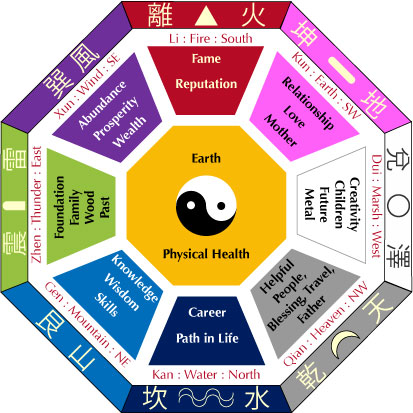
Bagua with colours, symbols and meaning.
Later Heaven Sequence
Note: 'South' is always found at the top of the Bagua
BAGUA MIRRORS
Mirrors alter space by eliminating the dimension of distance. Mirrors are associated with water and the moon.
Mirrors are visual echoes, connecting past to present and the conscious to the unconscious.
MIrrors are believed to transform negative chi into positive chi, hence promoting harmony (negative chi is called sha).
Mirrors are believed to expel negative energy, evil, bad spirits, since negative energy would be reflected backwards, evil spirit would be frightened by their own appearance when looking into the mirror and hence would disappear.
Concave mirrors are supposed to absorb negative energy, while convex mirrors are supposed to reflect negative energy. The ba gua functions as a force field around the flow of chi to and from the mirror.
Around 500 BC, mirrors were attached on people’s clothing for above mentioned reason.
Generally, there are three types of ba gua mirrors:
1) Octagon shaped wood/ material with a small round mirror in the middle; bright colours of green (symbolising spring, vigour, creativity), red (symbolising summer, illumination, growth) and goldish yellow (symbolising productiveness, success, late summer, autumn) stretch from the outer end of the mirror to the outer end of the octagon wood/ material.
2) Octagon shaped mirror framed by wood, glass will most likely cover the mirror. A Yin-Yang sign is painted in the middle, the ba gua are painted around the Yin- Yang sign in four colours: blue, green, red, and yellow.
3) A combination of a bagua mirror and door gods. Usually these are made of wood containing a mask like portrait of a protector or god, at times with an symbolistic animal. The protector or god holds a staff to ward off evil and at times a plaque declaring good fortune to those residing there. Above the scene is a regular ba gua mirror.
All Images © nationsonline.org
|
|




